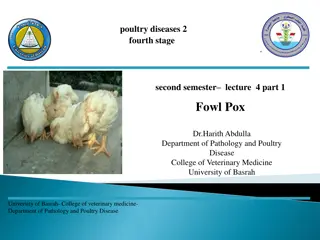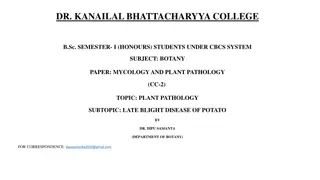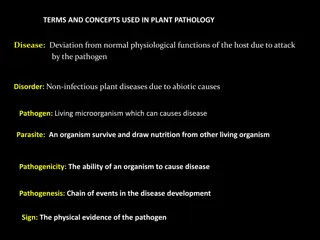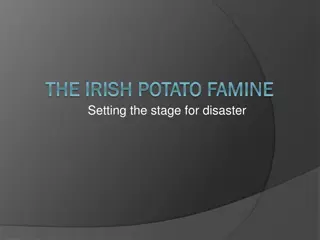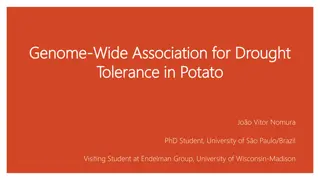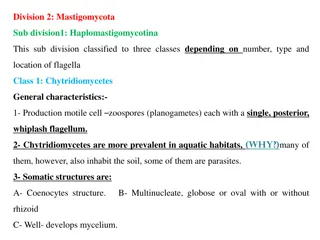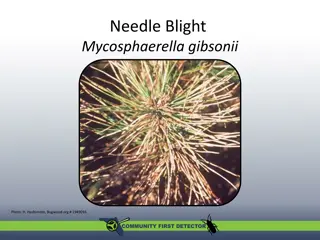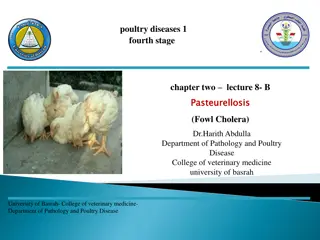Understanding SYNCHYTRIUM: Causes, Symptoms, and Control of Potato Wart Disease
Synchytrium endobioticum causes potato wart disease, prevalent in cool, moist climates globally. The disease affects underground parts, causing dark brown outgrowths on tubers and shoots. Infected tubers become deformed, tasteless, and unfit for consumption. Classification, symptoms, somatic structure, and control measures are discussed in detail.
Download Presentation

Please find below an Image/Link to download the presentation.
The content on the website is provided AS IS for your information and personal use only. It may not be sold, licensed, or shared on other websites without obtaining consent from the author. Download presentation by click this link. If you encounter any issues during the download, it is possible that the publisher has removed the file from their server.
E N D
Presentation Transcript
DR.NAMITA KUMARI Associate Professor Department of Botany Magadh Mahila College dr.namitakumari@gmail.com Patna University, Patna dr.namitakumari@gmail.com Mobile no 9472938409 April 2020
For B.Sc. Botany Honours SYNCHYTRIUM or
Contents 1 Introduction Classification Symptoms Somatic structure Life cycle Control
INTRODUCTION 2 Synchytrium endobioticum causes the black wart or wart disease of potato(Solanum tuberosum). The potato wart disease is widely distributed in all the potato growing regions of the world. It is prevalent in areas with a cool moist climate. In India it has been reported from Darjeeling district (West Bengal) and areas of Nepal. The fungal parasite cannot survive in hot places.
Classification 3 Division Mycota Sub-division- Eumicotina Class Chytridiomycetes Order Chytridiales Family Synchytriaceae Genus Synchytrium Species- endobioticum
Symptoms:- Usually the disease affects the underground parts of the host. Diseased Potato tubers appear as dark brown or black cauliflowers like outgrowths. Gall or Tumors may be formed on aerial as well. On shoots, the disease appears in the form of outgrowths on green twisted leafy structure. Due to the presence of the fungus, the host cells are stimulated to divide leading to increase in the number of host cells which contain resting sporangia- making wart like appearance outside. The wart is soft and pulpy. The warty tubers become deformed, tasteless, unfit for human consumption and a source of infection. 4
Infected Potato Tubers showing Wart infections. 6
T.S. of potato tuber through warty portions showing Resting sporngium( brown coloured) and adjacent multiplied cells. 7
Somatic structure 8 The thallusof Synchytrium endobioticum is a holocarpicendoparasite. It is a holocarpic fungus because thallus is naked and unicellular. The thallus forms a mass of naked, uninucleate amoeboid mass of protoplasm. Soon, a double layered chitinous wall develops around the thallus. The fungus is an endoparasite because it is endobiotic and occurs as a parasite in the epidermal cells of the host.
Life-cycle. 9 Life cycle of S. endobioticum has been studied by Curtis( 1921) and Kohler (1923,1931) . Two phases Asexual phase and Sexual phase. Asexual phase:- There are following stages 1. Infection- The zoospores swims in a film of water in the contaminated soil and finally reach a potato plant ie either on tuber or stolon. The zoospore retracts its flagellum and germinates by putting out a peg like penetration tube, which pierces the cuticle and the wall of the epidermal cell. Subsequently the uninucleate protoplast of the zoospores enters the host as a naked mass. 2.Prosorus stage- The unicellular parasite absorbs food material from host cell, increases in size, and become pear shaped. Thallus secrets a wall around it which is differentiated into an outer, thick , golden yellow exospore and inner thin, hyaline endospore . The nucleus also increases in size. Now the mature thallus is called Prosorus.
Life- cycle Asexual phage (contd) 11 Meanwhile the adjacent epidermal cells and the surrounding cortical cells stimulated and divide rapidly and repeatedly to form a minute gall or tumor or wart like tissue or rosette of cells. 3. Germination of prosorus- The mature prosorus germinates within the host cell. A pore is formed in the thick exospore layer. The thin, hyaline endospore iayer extrudes through the pore in the form of vesicle. The contents of prosorus migrate into vesicle which come out in the upper half of the host cell. During migration, prosorus nucleus divides( by mitosis) repeatedly into 32 daughter nuclei. The multinucleate protoplast of the vesicle is now partitioned by thin walls into4 to 9 multinucleate polygonal segments. Now each segment functions as Sporangium and the whole mass is known as Sorus.
Life- cycle Asexual phage (contd) 12 4. Sporangia- The nuclei of each sporangium undergo further mitotic divisions to form 200 to 300 daughter nuclei. Now each nucleus with its surrounding cytoplasm becomes metamorphosed into posteriorly uniflagellate zoospores. In this way about 1500 zoospores are produced from a single original zoospore which infected the tuber. The mature sporangia in the sorus absorb water, swell and exert pressure rupturing host cell wall and vesicle membrane. The zoospores came out through ruptured sporangial wall, swim in a film of water in the soil. Some of these may reinfect the host and repeat the sequence outlined above. Tis completes the asexual phase in the Life-cycle of Synchytrium.
Life- cycle Sexual phage 14 1.Gametangia- Under conditions of scarcity of water (dry weather) , the segments of prosorus function as Gametangia. The gametangia produce Planogametes similar to zoospore. The gametes are smaller than zoospores and fuse in pairs.Fusion occurs between planogametes of different gametangia in the same sorus.Plasmogamy is followed by karyogamy. 2.Zygote- The diploid zygote formed by the fusion of planogametes is biflagellate. It swims in film of water in the soil, come in contact with host, withdraw flagella, pierces cuticle and the wall of epidermal cell with peg like germ tube and sinks to the bottom of the infected hypertriphied epidermal cellof the host and grow in size. 3.Resting Sporangium- The presence of zygote in the host stimulates to divide repeatedly the surrounding cells.The diploid zygote(parasite) enlarges and is enclosed in a thick , ornamanted,two layered wall to become Resting Sporangium or Winter spore. These are released into the soil by the decay of
Life- cycle Sexual phage(Contd.) 15 the infected tubers. In the soil they remain dormant though winter and can remain viable for more than 5 years (Sharma and Commack 1976). 4.Germination of Resting Sporangium- It germinates, first divides by Meiosis division, then divide and redivide by Mitosis forming so many haploid Nuclei. Each nucleus with surrounding cleavage protoplasts metamorphoses into posteriorly uniflagellate Zoospores. The outer layer of sporangial wall ruptures the zoopores released outside. These zoospores are larger in size than Asexual cycle. They may infect the host to repeat the Asexual phase. In this way Life-Cycle completed.
CONTROL 17 1. To reduce spread of the pathogen, Quarantine regulations are practicised. In India, the entry of potatoes from Darjeeling Hills, where wart disease is known to occur, has been prohibited. 2.A number of varieties which are immune to this disease had been produced in recent years. Use of Resistant varieties had considerably prevented spread of disease. For example- Maris piper, 3.The application of LIME and use of FUNGICIDES in the soil before planting have also given some useful results.





